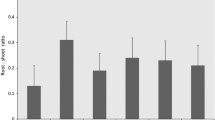Abstract
Leaf production, leaf fall, leaf protein and net primary productivity have been reported for 4-year-old fodder trees in the mid-western Himalaya (altitude 1350 m; rainfall 1100 mm). The species include; Grewia optiva, Robinia pseudoacacia and Celtis australis growing in the open and Quercus glauca, Q. leucotrichophora and Ilex odorata growing in the forest. G. optiva, R. pseudoacacia and C. australis showed two distinct periods of leaf flush, and their leaves were short-lived (180 to 360 days) compared with the remaining three species which retained their leaves for more than two years, and had only one flush period during March–April. The open site species showed much higher leaf production, and the leaves contained a significantly (P < 0.05) higher protein content, compared with the forest group. Net primary productivity of G. optiva, C. australis and R. pseudoacacia was significantly (P < 0.05) higher than the forest species, which may be related to their high leaf production and rapid turnover rate of the leaves. The results are useful for management of these species in agroforestry systems.
Similar content being viewed by others
References
Allen, SE, Grimshaw, HM, Parkinson, JA and Quarmby, C (1974) Chemical Analysis of Ecological Materials. Blackwell Scientific Publications, Oxford
Bazzaz, FA and Pickett, STA (1980) Physiological ecology of tropical succession: a comparative review. Ann Rev Ecol Syst 11: 287–310
Bentley, BL (1979) Longevity of individual leaves in a tropical rain forest understorey. Ann Bot 43: 119–121
Boojh, R and Ramakrishnan, PS (1982) Growth strategy of trees related to successional status. II. Leaf dynamics. For Eco Manag 4: 375–386
Borchert, R (1980) Phenology and ecophysiology of tropical trees: Erythrina poeppigiama O.F. Cook. Ecology 61: 1065–1074
Bormann, FH and Likens, GE (1979) Pattern and Process in a Forested Ecosystem. Springer-Verlag, New York
Chabot, BF and Hicks, DJ (1982) The ecology of leaf life spans. Ann Rev Ecol Syst 13: 229–259
Chapin, FS, Johnson, DA and McKendrick, JD (1980) Seasonal movement of nutrients in plants of differing growth form in an Alaskan Tundra ecosystem: implications for herbivory. J Ecol 68: 189–209
Harper, JL and White, J (1974) The demography of plants. Ann Rev Eco Syst 5: 419–463
Horn, HS (1971) The Adaptive Geometry of Trees. Princeton Univ Press, Princeton
Kaushal, PS (1978) Screening of biul tree (Grewia optiva Burrette) for superior nutritive strain. M. Sc. Thesis, H.P. Agri University, Solan, India
Khosla, PK, Pal, RN, Negi, SS and Kaushal, PS (1980) Phenotypic variation in nutritional parameters in Grewia optiva. Silvicultura 30: 328
Khosla, PK, Pal, RN, Negi, SS and Kaushal, PS (1982) Genetic evaluation of nutritional parameters in leaf fodder species, Grewia optiva Burett. In: Khosla, PK, ed, Improvement of Forest Biomass, pp 71–79. ISTS, Solan, India
Kozlowski, TT (1971) Growth and Development of Trees. Vol. I. Academic Press, New York
Longman, KA and Jenik, J (1974) Tropical Forest and its Environment. Longman, London
Negi, SS, Pal, RN and Ehrich, C (1979) Tree fodders in H.P. (India): an introduction to six most common fodder trees in the Himachal Pradesh state of India and feeding value for cattle. German Agency for Technical Cooperation (GTZ) Eghborn, Germany, 68 pp
Newbuold PJ (1967) Methods for Estimating Primary Productivity of Forests. IBP Handbook No 2
Sen, KC (1953) Animal Nutrition Research in India. McMillan and Co, London
Shukla, RP and Ramakrishnan, PS (1984) Leaf dynamics of tropical trees related to successional status. New Phytol 97: 697–706
Toky, OP, Kumar, P and Khosla, PK (1989a) Structure and function of traditional agroforestry systems in the Western Himalaya. I. Biomass and productivity. Agroforestry systems 9: 47–70
Toky, OP, Kumar, P and Khosla, PK (1989b) Structure and function of traditional agroforestry systems in the Western Himalaya. II. Nutrient cycling. Agroforestry systems 9: 71–89
.Watson DJ (1956) Leaf growth in relation to crop yields. In: Milthorpe FL, ed, The Growth of Leaves, pp 178–191. Butterworths, London
Whittaker, RH and Marks, PL (1975) Methods of assessing terrestrial productivity. In: Lieth, H and Whittaker, RH, eds, Primary Productivity of the Biosphere, pp 55–119. Springer-Verlag, New York
Author information
Authors and Affiliations
Rights and permissions
About this article
Cite this article
Khosla, P.K., Toky, O.P., Bisht, R.P. et al. Leaf dynamics and protein content of six important fodder trees of the western Himalaya. Agroforest Syst 19, 109–118 (1992). https://doi.org/10.1007/BF00138501
Issue Date:
DOI: https://doi.org/10.1007/BF00138501




